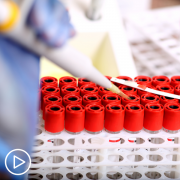Tag Archive for: Nina Shah
What Should You Ask Your Doctor About Myeloma Testing?
What Should You Ask Your Doctor About Myeloma Testing? from Patient Empowerment Network on Vimeo.
Testing and test results may affect your myeloma care and treatment. Dr. Nina Shah, a myeloma expert, shares key questions to ask your doctor about testing and reviews testing techniques for myeloma.
Dr. Nina Shah is Associate Professor of Medicine in the Fepartment of Medicine at the University of California San Francisco (UCSF) and treats patients at the Hematology and Blood and Marrow Transplant Clinic at UCSF Helen Diller Family Comprehensive Cancer Center. Learn more about Dr. Shah, here.
Related Programs:

|

|

|
Transcript:
Katherine Banwell:
If a patient wants testing beyond the standard, what should they be asking their doctors for?
Dr. Shah:
Well, thankfully a lot of these tests can be done as a standard. We actually have some approved testing for it. So, the most important thing is to ask the doctor at all. For example, the patient may ask, 1.) “When will my next bone marrow biopsy be?” and 2.) “When I get that bone marrow biopsy, will you be looking at cytogenetics and FISH?” and 3.) “When you get the bone marrow biopsy, will you be also looking for minimal residual disease?” And finally, “What technique will you use to look for that minimal residual disease?” There are different ones that the patients might find useful to know about.
Katherine Banwell:
What are some of the different techniques?
Dr. Shah:
There are a variety of ways that we can look for minimal residual disease. One of them is called flow cytometry. What that is is you send all the cells that are in the bone marrow through a chute, and in that chute you can sort of detect one or however many cells that are – that have a specific characteristic on their cell surface.
You think of it as a bunch of balls with lollipops sticking out of it. And based on the characteristics of those lollipops, you can tell if there are any plasma cells or myeloma cells. Another thing we do with minimal residual disease, another technique, is called the next-gen sequencing or NGS.
And for that, we need to know the specific DNA sequence that is very personal to your myeloma cells. So, your particular plasma cell or the cancer cell will have a sort of sequence, a specific sequence that can be identified when you’re first diagnosed. And if you have access to that tissue, that can be sent off to the company, and they use that as sort of a template or a measure – an individual identification. And then, they scan the subsequent bone marrow samples against that to see if there’s any sequence that matches that original one, and that’s the way you can detect one in a million positive cells, if there are any.
How Is Minimal Residual Disease (MRD) Testing Used in Myeloma Care?
How Is Minimal Residual Disease (MRD) Testing Used in Myeloma Care? from Patient Empowerment Network on Vimeo.
Myeloma expert Dr. Nina Shah explains minimal residual disease (MRD) and how the results of this test may impact patient care and treatment.
Dr. Nina Shah is Associate Professor of Medicine in the Fepartment of Medicine at the University of California San Francisco (UCSF) and treats patients at the Hematology and Blood and Marrow Transplant Clinic at UCSF Helen Diller Family Comprehensive Cancer Center. Learn more about Dr. Shah, here.
Related Programs:

|

|

|
Transcript:
Katherine Banwell:
What is minimal residual disease testing, and when should it take place?
Dr. Shah:
Minimal residual disease is exactly what it sounds like. It’s the disease that you can’t see under the microscope, but it’s still there.
And I sort of equate it to the little deep food particles that are in a pot after you clean it and really, really scrub it, but still, something is in there. And that’s what it is for myeloma. And really, that depends on how sensitive your test is. We now know we can test for at least one in a million cells by some advanced techniques, and we like to test to see if there’s any disease left after certain treatments are done – for example, after a patient undergoes an autologous stem cell transplant.
Katherine Banwell:
What impact do results have on care decisions?
Dr. Shah:
Minimal residual disease testing can be useful for patients to understand the true burden of their disease. For example, it may be that there’s no more M-protein in the blood, or the light chains are normal, or even the bone marrow showed no plasma cells. But the minimal residual disease testing may show that, in fact, there are a few cells still in there, and that can help patients to decide, “Yes, I want proceed with maintenance therapy,” for example, or “No, I would not like to.” Although, we generally recommend it, patients like to have as much information as possible to make their decisions.
How Are Cytogenetics Used in Myeloma Care?
How Are Cytogenetics Used in Myeloma Care? from Patient Empowerment Network on Vimeo.
Myeloma expert, Dr. Nina Shah, explains cytogenetics and how results of these tests affect care and treatment for myeloma patients.
Dr. Nina Shah is Associate Professor of Medicine in the Fepartment of Medicine at the University of California San Francisco (UCSF) and treats patients at the Hematology and Blood and Marrow Transplant Clinic at UCSF Helen Diller Family Comprehensive Cancer Center. Learn more about Dr. Shah, here.
Related Programs:

|

|

|
Transcript:
Katherine Banwell:
What is cytogenetics, and how is it used in myeloma patient care?
Dr. Shah:
We use the term cytogenetics and FISH sort of interchangeably, and really what it is, is the DNA characteristics of the bad plasma cells. So, the myeloma cells, and a lot of them may have changes in their DNA that are what we call clonal, meaning that they’re in a significant percentage of those cancer cells, or they might be non-clonal, which are less significant. But it’s the way the DNA is put together or maybe cut and pasted so that it changes the characteristics and maybe the aggressiveness of the disease.
Katherine Banwell:
What is the goal of this in-depth testing? Are there specific markers you’re looking for?
Dr. Shah:
When we look for things like cytogenetics and send FISH testing, we look to see if patients have changes that might make their disease may be more aggressive.
For example, it may cause their plasma cells, the myeloma cells, to grow faster or more aggressively. So, we look for changes that might, for example, have a deletion of a certain chain that puts the brakes on tumors, or it may have a translocation, which is when the chains sort of do-si-do together and that makes the cells grow faster.
Understanding Your Role in Myeloma Treatment Decisions
Understanding Your Role in Myeloma Treatment Decisions from Patient Empowerment Network on Vimeo.
Many factors are considered when choosing a myeloma treatment. Dr. Nina Shah, a myeloma expert, reviews how treatment decisions are made and the patient’s role in deciding on an approach.
Dr. Nina Shah is Associate Professor of Medicine in the Department of Medicine at the University of California San Francisco (UCSF) and treats patients at the Hematology and Blood and Marrow Transplant Clinic at UCSF Helen Diller Family Comprehensive Cancer Center. Learn more about Dr. Shah, here.
Related Programs:

|

What Key Questions Should Myeloma Patients Ask About Treatment? |

|
Transcript:
Katherine Banwell:
What are the main factors that you take into consideration before a treatment approach is decided on?
Dr. Shah:
We always have to remember that treating a patient is also treating a person. So, it’s not just about what the disease the patient has but who the patient is. And so, we take into consideration goals that the patient as well as other health factors that may take – be taken into consideration. For example, the patient may have high blood pressure or a heart condition. But regarding the disease, we really also take into consideration what the profile of the disease is, maybe how much disease burden the patient has and some genetic factors that may impact our decision-making.
Katherine Banwell:
What is the patient’s role in treatment decisions?
Dr. Shah:
The patient should always be the center of the decision-making. I think that’s a really important thing for us to remember because ultimately, it’s the patient who has to make the decision and has to withstand the treatment. Alongside of that there may be some caregivers as well, but the patient has to, 1.) understand the disease, and 2.) understand the treatment options. So, it’s best if the patient has as much information as possible.
Katherine Banwell:
Are treatment considerations different for patients with relapsed disease?
Dr. Shah:
For patients with relapsed disease, there’s a lot of things to consider that may not have been true when the patient was first diagnosed. For example, you always have to think of what maybe the patient had as a prior – excuse me, as a prior treatment, and also how the patient tolerated it.
What You Should Know About Myeloma Clinical Trial Participation
What You Should Know About Myeloma Clinical Trial Participation from Patient Empowerment Network on Vimeo.
Myeloma expert Dr. Nina Shah shares her view on why patients should consider a myeloma clinical trial and provides advice for finding and participating in a trial.
Dr. Nina Shah is Associate Professor of Medicine in the Department of Medicine at the University of California San Francisco (UCSF) and treats patients at the Hematology and Blood and Marrow Transplant Clinic at UCSF Helen Diller Family Comprehensive Cancer Center. Learn more about Dr. Shah, here.
Related Programs:

Myeloma Treatment: When Should a Clinical Trial Be Considered? |

|

|
Transcript:
Katherine Banwell:
Why should a patient consider participating in a clinical trial?
Dr. Shah:
I am a huge fan of clinical trials, as you probably figured out. And the reason for that is that it’s the only way we know how to do things. And for everything we figured out about myeloma, it’s because patients participated beforehand in clinical trials. So, of course, it’s a way to pay it forward. But aside from that, there’s an experience that a patient can have on a clinical trial that is really unlike other experiences that patients may have. For example, they will be given the opportunity to understand a lot about their disease that maybe they may not have understood before, and they may have the opportunity to try a treatment that might be beneficial.
There are no guarantees in a clinical trial, and that informed consent procedure where the doctor tells you about the risks, benefits, and alternatives, should be very comprehensive and clear. But it does allow for patients to get access to something they may not have had before. And I think one of the other things that’s important is that it’s sort of a concierge service, I would say, with clinical trials, because you have to be monitored very closely. So, of course, all your symptoms have to be known. And you get a little bit more time, I would say, when you participate in a clinical trial because we really want to know the pluses and minuses of these treatments.
Katherine Banwell:
How can patients participate in research? Where do they start?
Dr. Shah:
Participating in research is a great opportunity for patients and something that we’re grateful for as myeloma physicians. There are many ways to look on various websites. There are things like SparkCures. There’s ClinicalTrials.gov. You can look at any academic website. Almost all advocacy groups also have opportunities for you to look at clinical trials.
And any time you get the opportunity to look at patient education sites, they may have a link for you to look for other clinical trials that might be relevant to your particular stage in disease or the particular kind of myeloma that you have. When in doubt, please, if you have a chance, talk to your local oncologist perhaps to maybe refer you to a myeloma specialist. We can do this by Zoom now, so there should be no reason that we can’t be a part of your care team at least for a consultation.
An Expert’s Hopeful Outlook on Myeloma Research and Treatment
An Expert’s Hopeful Outlook on Myeloma Research and Treatment from Patient Empowerment Network on Vimeo.
Myeloma expert Dr. Nina Shah shares why she’s hopeful about research and treatment, including immunotherapy and CAR T-cell therapy.
Dr. Nina Shah is Associate Professor of Medicine in the Department of Medicine at the University of California San Francisco (UCSF) and treats patients at the Hematology and Blood and Marrow Transplant Clinic at UCSF Helen Diller Family Comprehensive Cancer Center. Learn more about Dr. Shah, here.
Related Programs:

|

|

|
Transcript:
Katherine Banwell:
Is there emerging myeloma research that you feel patients should know about? And what are you excited about?
Dr. Shah:
There are so many aspects of myeloma treatment and the patient’s journey that we have been looking at. One of the things that I’m most excited about and I do a lot of research in is immunotherapy, which includes both CAR T-cell therapy as well as natural killer cell therapy and bispecific T-cell engager and other novel immunotherapies.
And I think these are interesting, because they allow for the patient’s own immune system sometimes to be used to kill the myeloma. And that’s something that is spring-boarding the way we treat myeloma to give patients better outcomes with less toxicity, if you can believe that. So, we’re really excited about that.
The other thing I’m really excited about is patient experience research that we’re doing. We now know that multiple myeloma patients live for maybe over a decade, and those patients are on a marathon of treatment; and how that treatment is a part of their life is very important in their experience as a patient. So, we’re trying to make that easier for patients as they go through, for example, transplants or maybe immunotherapy to give them more information, more control and more ability to talk about their symptoms with their provider and their care team.



